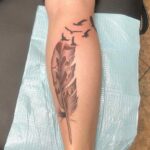Table of Contents
There’s a certain rhythm to life in a tattoo parlor. The buzz of the machine, the hush of anticipation, the rich smell of ink, and the collective exhale when the artist lifts their hand. After all, you’ve just transformed into a living, breathing canvas. Then, a week or so down the line, your shiny new artwork starts to peel, flaking like a croissant fresh out of a Parisian bakery. If you’re a first-timer, it’s enough to give you heart palpitations. But fret not, dear readers – this is all part of the ride on the tattoo carousel.
Throughout my years inking and being inked, I’ve fielded countless anxious queries from my clients. “Is my tattoo supposed to peel this much?” or “I thought my tattoo was going bad!” Let’s lay those fears to rest right here. The peeling stage, although less glamorous, is as integral to your tattoo’s story as the moment the first stroke of ink met your skin.

There’s no one-size-fits-all answer to the pressing question – how long does this peeling business last? Just as every tattoo tells a unique story, every healing process has its own timeline. Picture Mabel, an effervescent young woman who walked into our parlor with the determination of a prizefighter, requesting a small, delicate daisy on her ankle. Her peeling phase lasted barely a week, as breezy and swift as her presence.
Conversely, consider the towering Bruno, a gentle giant with a heart as big as his biceps, who graced us with his decision to immortalize an intricate Celtic knot across his broad back. His masterpiece took a good two weeks to traverse through the peeling stage, a testament to the depth of the art he now wears with quiet pride.
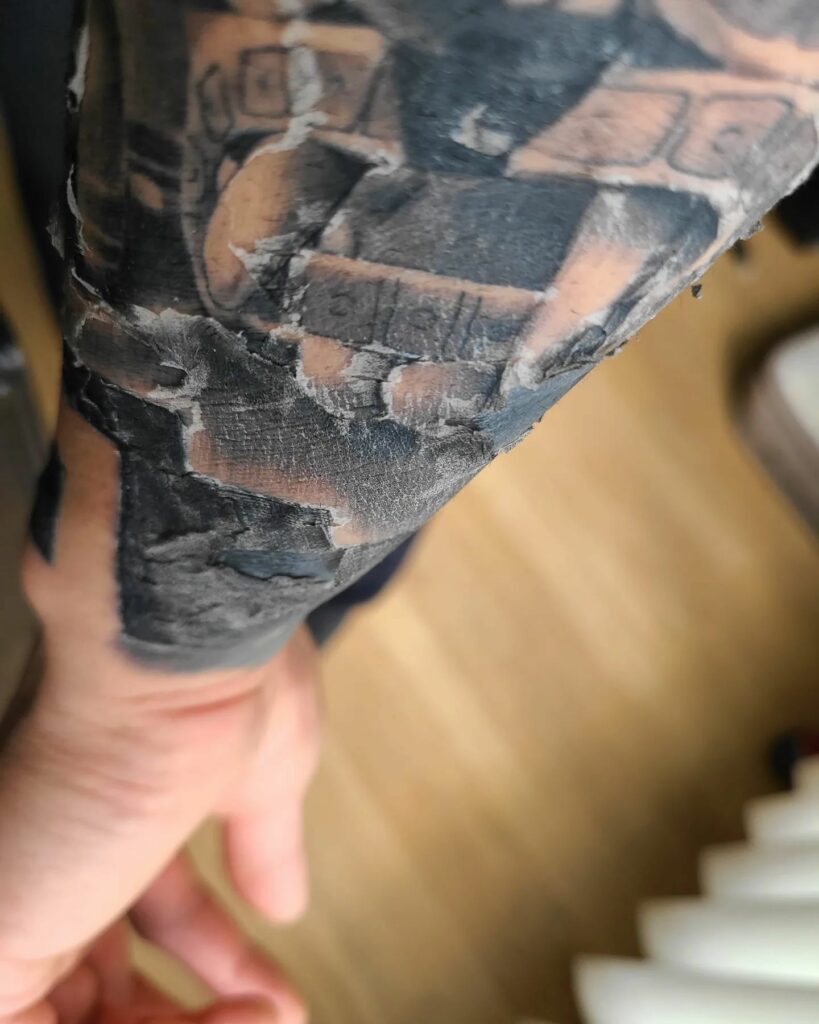
In the great tapestry of tattoo experiences, one thing remains consistent – the peeling phase, whether it dances across a week or stretches across two, is a crucial step in your skin’s magical transformation. So remember, when you see those flakes starting to form, don’t be alarmed. It’s not your tattoo waving a white flag; it’s your skin, quite literally, shedding its old self to reveal the vibrant, permanent artwork underneath.
Tattoo Peeling Process
Now, the duration of the peeling process is as varied as the tattoos we adorn ourselves with. Take this lively dame, Rosie, a veteran in the world of tattoos. She strolled into my parlor one sunny afternoon, her sparkling eyes set on a small but bold crescent moon on her wrist. Rosie’s petite lunar ode started its peeling process within a week.
Then there’s Diego, a spirited skateboarder with dreams as expansive as his canvas-like back, inked with an awe-inspiring depiction of a mythical phoenix. His expansive artistry took a good fortnight to peel and heal, echoing the mythological tale etched onto his skin.
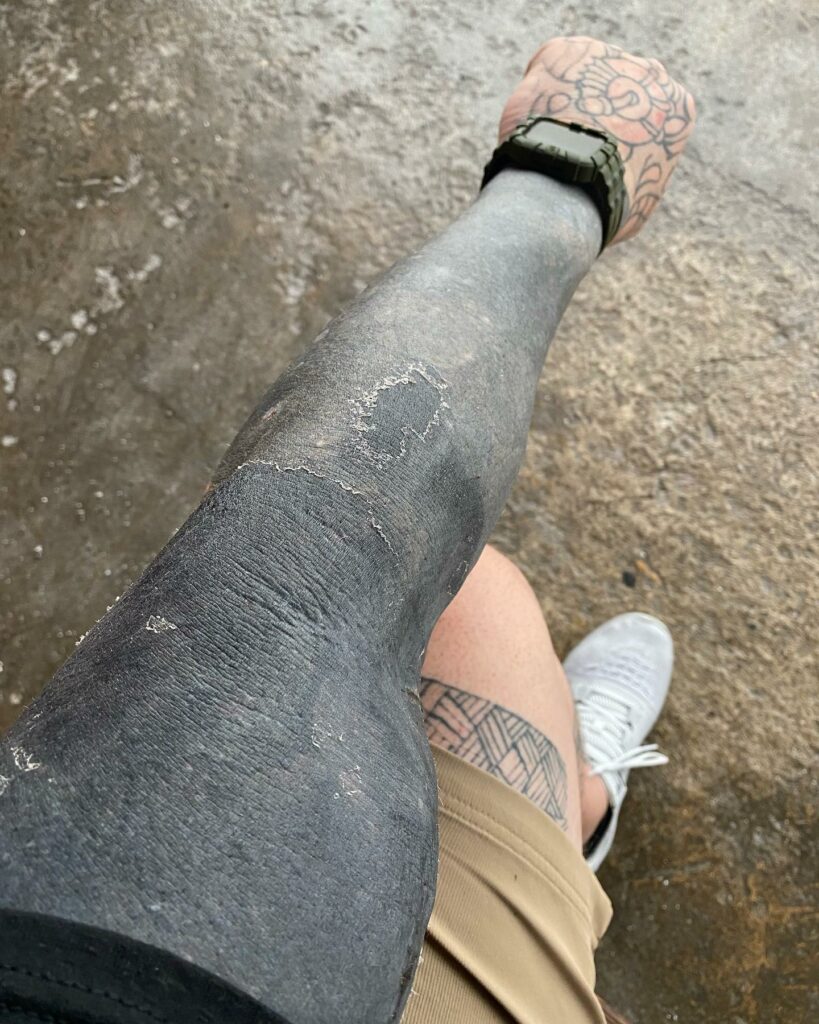
If you notice your tattoo behaving differently, remember that like people, tattoos are unique. Some might not start peeling until after five days, while others might take longer than two weeks. It’s all part of the dance.
And what’s our role in this delicate ballet? It’s simple.
Firstly, let nature do its thing. Those peeling pieces will shed when they’re good and ready. Meanwhile, lend your skin a helping hand with a moisturizer – your skin’s secret weapon in the battle for rejuvenation. This will not only expedite healing but also bid adieu to that flaky appearance.
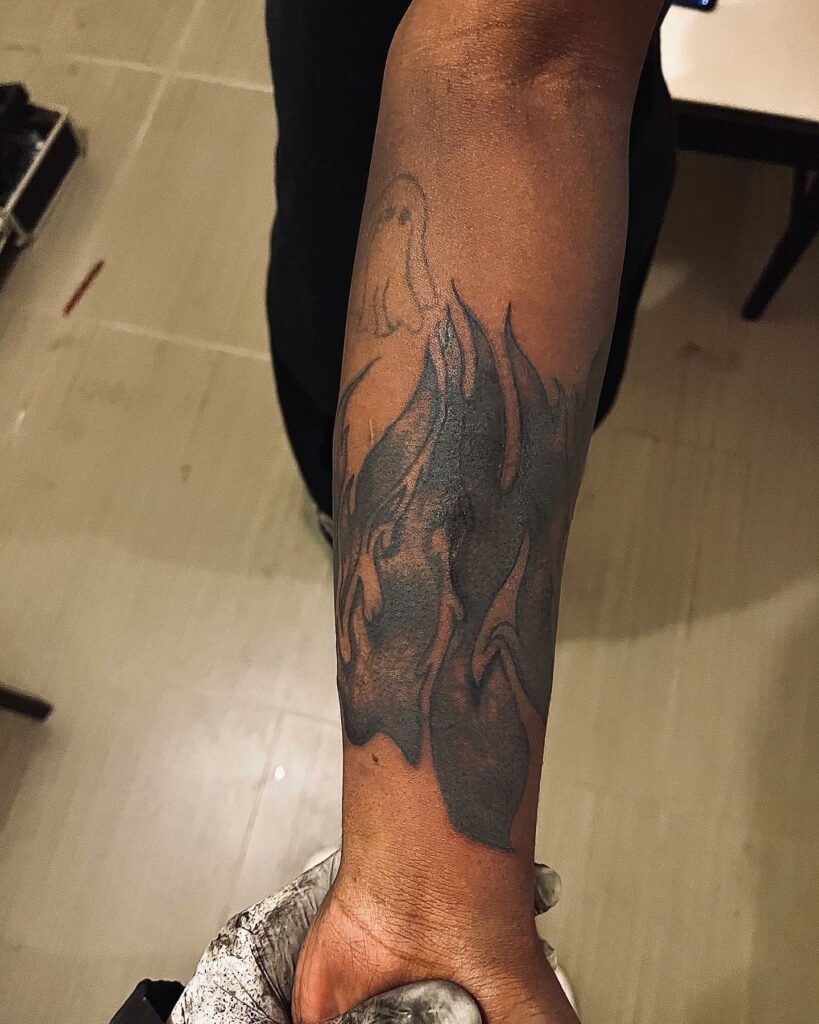
Next up, hygiene. A clean tattoo is a happy tattoo. However, be gentle. The scabs aren’t quite ready to be evicted just yet. And when it comes to drying, consider ditching your fluffy bath towel for a softer paper towel to avoid harsh rubbing and bacteria.
Now, here’s the golden rule – resist the urge to scratch, pick, or shave the tattooed area. Why, you ask? This can lead to unsettled ink popping out, scarring, and even distortion within your tattoo. Not to mention swimming – keep that fresh ink away from water as if it’s the wicked witch of the west. Even excessive sweat can mess with your healing tattoo.
If you’re a sun worshipper, you might need to take a break, especially during the first two weeks post-inking. Sunburn during the peeling phase can send your skin cells into a frenzy, prolonging the healing process, or worse, triggering blisters and potential infections. So, do your tattoo a favor and give it some shade, and plenty of sunscreen once it’s healed.
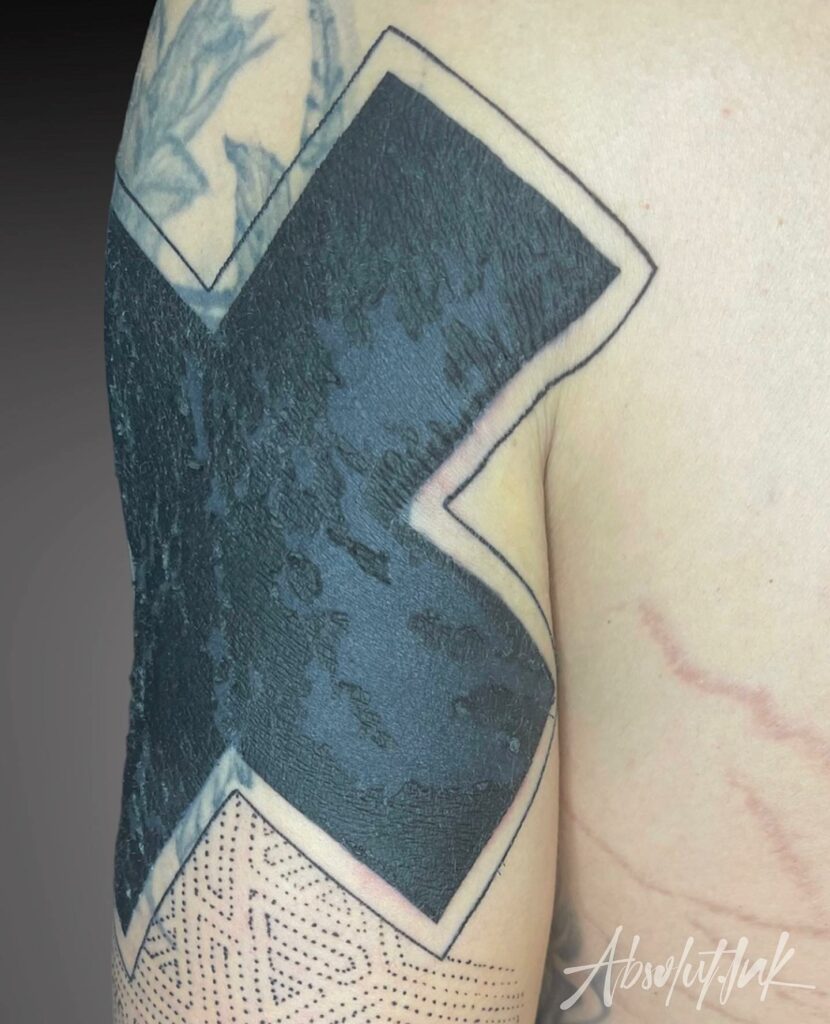
As you near the end of the peeling process, you might notice your tattoo looking different, possibly duller or faded. But here’s a fun fact – that’s merely a layer of dead skin playing hide and seek with your new tattoo. Patience is key here; let your skin do its thing, and soon enough, you’ll be flaunting your tattoo in all its vibrant glory.
In a nutshell, the peeling process is an essential part of your tattoo journey. So, when it begins, take it in stride and remember – it’s just your body embracing the change and revealing the masterpiece underneath.
Cleaning Ritual
When it comes to moisturizing, your tattoo’s best ally is a fragrance-free, dye-free, hypoallergenic lotion. Products like Lubriderm or Aquaphor are often tattoo artist favorites because they keep the skin hydrated without irritating it. However, be wary of overdoing it – a thin layer is all you need. Your skin needs to breathe for optimal healing.
As for the cleaning ritual, let’s break it down step by step:
- Wash Your Hands: Always start with clean hands to avoid introducing any unnecessary bacteria to your healing tattoo.
- Gently Clean the Tattoo: Use lukewarm water and a mild, fragrance-free soap. Avoid scrubbing or using a washcloth, as it could be too abrasive. Instead, use your hands to gently clean the tattooed area.
- Pat Dry: After rinsing, gently pat the tattoo dry with a clean, soft paper towel. Rubbing could damage the tattoo and slow down the healing process.
- Apply a Thin Layer of Moisturizer: Once the tattoo is dry, apply your chosen moisturizer. Remember, less is more – you want the tattoo to stay moisturized but not suffocate under too much lotion.
- Repeat: Aim to wash and moisturize your tattoo 2-3 times a day, depending on how much you sweat or the dirt exposure.
Bear in mind, these steps should be followed until your tattoo has fully healed, which can typically take 2-4 weeks.
As with everything, everyone’s skin reacts differently, and these are general guidelines. If something feels off or the tattoo doesn’t seem to be healing properly, don’t hesitate to reach out to your tattoo artist or a healthcare professional. They’re there to guide you through this journey and ensure your tattoo looks as vibrant and fantastic as you envisioned.
Risks & How To Deal With Them
Navigating through the healing process of your tattoo isn’t always smooth sailing, and being informed is your best defense. While most tattoos heal without incident when given the proper care, it’s essential to keep an eye out for potential complications.
A common issue some people encounter is an allergic reaction. Certain individuals might have a sensitivity or allergy to specific types of ink, particularly colored ink. Signs of an allergic reaction might include a rash, itching, or swelling around the tattooed area. If you suspect an allergic reaction, contact a healthcare professional for advice.
Then there’s tattoo blowout, an unfortunate situation where the ink spreads beneath the skin, resulting in a blurred or shadow-like appearance. This often happens when the ink is injected too deeply into the skin. Unfortunately, there’s no quick fix for a blowout, and it’s best to discuss with your artist if you notice such signs.
Another complication to watch for is keloid formation, where the skin heals excessively, creating raised, fibrous tissue. If you’re prone to keloids, let your tattoo artist know beforehand, and they can adjust their technique or advise on the best locations for your tattoo.
Lastly, infection, while relatively rare, can occur if the tattoo isn’t adequately cared for during the healing process. Signs of infection include increased redness, warmth around the tattoo, severe pain, pus, or a foul odor. If you suspect an infection, it’s crucial to seek medical attention immediately.
While these potential complications might sound scary, remember, most tattoos heal without any issues. By knowing what to look out for, following your aftercare instructions, and maintaining open communication with your tattoo artist, you’re well on your way to enjoying your new tattoo with minimal complications.
Best Products To Help With A Peeling Tattoo
Sure, let’s look at some of the top products that can help during the peeling phase of your tattoo, along with their pros and cons.
- Aquaphor Healing Ointment
- Pros: It’s dermatologist-recommended and a favorite among many tattoo artists. Aquaphor is fragrance-free, preservative-free, and excellent for keeping the tattoo area moisturized.
- Cons: It’s petroleum-based, which some people might find too heavy or greasy. Over-application can suffocate the skin, so use sparingly.
- After Inked Tattoo Moisturizer
- Pros: Specifically designed for tattoo aftercare, this lotion is enriched with Grape Seed Oil and is both fragrance-free and non-petroleum based. It’s also vegan-friendly and cruelty-free.
- Cons: It’s pricier than some other options on the market. Some users report that the formula is too thin, requiring more frequent applications.
- Hustle Butter Deluxe
- Pros: This is a 100% vegan product, made from natural ingredients like Shea, Mango, and Aloe Butter. It’s designed to reduce redness, swelling, and bleeding.
- Cons: Some people find the smell too strong, and it’s also one of the pricier options available.
- Lubriderm Daily Moisture Lotion
- Pros: It’s a reliable, fragrance-free, dye-free, and affordable option that’s easy to find in most drugstores.
- Cons: It might not be as specialized for tattoo care compared to other products, and some find it not as moisturizing for heavily tattooed or larger areas.
- Tattoo Goo Aftercare Lotion
- Pros: Tattoo Goo is designed specifically for tattoo healing. It’s free from petroleum, lanolin, and mineral oils. It also includes Panthenol and Olive Oil, known to help skin regeneration.
- Cons: Some users report an allergic reaction or sensitivity to the product, and it’s not as widely available as some other brands.
Remember, everyone’s skin is unique, and what works for one person may not work for another. It’s always a good idea to patch test a new product and consult with your tattoo artist for personalized advice.
Conclusion
And there we have it, the magnificent journey of your skin’s transformation into a brilliant canvas. Deciding where to place your tattoo is just as personal as choosing your design, an intricate dance between your lifestyle, pain threshold, and aesthetics. A discreet tattoo on the ankle might suit a professional working in a corporate environment, while a sleeve might better represent someone who revels in the unabashed display of their artistry.
Cost, of course, is a defining factor, and it varies widely based on the size, complexity of design, and the expertise of your chosen artist. Be prepared for a range anywhere from $50 for a basic, small tattoo, to several thousand for a large, intricate piece by a famed tattoo artist. Remember, this is a piece of art you’ll wear for life – so consider it an investment rather than an expense.
Of course, every rose has its thorns, and tattoos are no exception. While uncommon, risks such as allergic reactions, skin infections, or scarring can occur. It’s essential to follow the aftercare instructions to a T and choose a reputable, hygienic tattoo studio to mitigate these risks.
At the end of the day, tattoos are a beautiful journey of self-expression and transformation. So, when your tattoo starts its peeling dance, take a moment to appreciate this essential phase, knowing that it’s all part of your skin’s magnificent journey to permanently showcasing a piece of your unique story.


